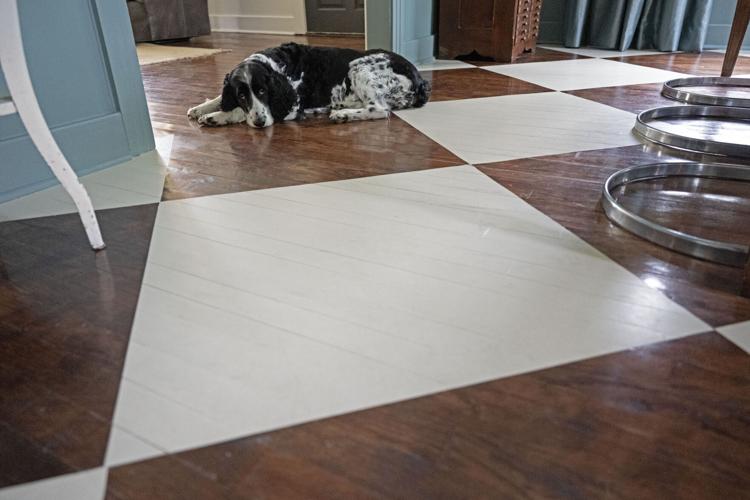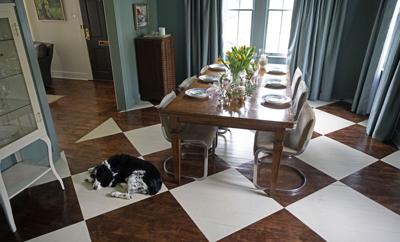Looking to the stars is the typical direction when seeking inspiration. However, in the interior design world, looking down holds power, too. Specifically, looking at the floor — that is.
Floor inspiration goes far beyond basic construction material.
Painted floors, from castles to cottages, can be executed in any space and in an array of patterns, adding a touch of whimsy, color or unexpected design element to a space.
In Baton Rouge, Kelly Field enlisted the help of decorative paint artist Libby Willingham to create a painted harlequin design in her neo-traditional kitchen and dining room. The result is a beige oversized-diamond pattern that both contrasts and complements the 83-year-old wood floors in her C.S. Lewis home near Dalrymple Drive.

Springer Spaniel Max lays on the kitchen floor of his owner Kelly Field’s residence, Monday, April 1, 2024, on June Street in Baton Rouge, La.
"I think it makes a statement," Field said of the end result. "I think it's timeless and beautiful."
Appreciation for hand-stenciled designs on floors dates back to 15th-century France when homeowners adorned the floors under dining tables with painted cloths. These cloths featured decorative patterns and motifs and were laid on top of existing flooring before being sealed with varnish. The trend was later adopted in the American colonies in the early 18th century.
Eventually, artists ditched the cloths and opted to paint directly onto floors.
"Although initially a practical, low-cost solution for decorating one’s floors, faux painting, graining and marbling became an increasingly advanced art form," according to a post from legendary designer Bunny Williams. "Compass rose designs (a nod to floor cloths’ maritime origins) mimicked elaborate wood inlay, and refined borders added elegance."

Kelly Field enlisted the help of decorative paint artist Libby Willingham to paint a harlequin design in her kitchen and dining room.
Today, painted floors are still a versatile, cost-effective way to give a room a new focal point. Artists (or those brave enough to do it themselves) paint anything from geometric patterns, mosaic tiles and one-dimensional Oriental rugs, complete with fringe, to simple stripes or a solid color.
The inspiration for the design in Field's home came from her daughter's nursery years ago, which also included a harlequin pattern. Willingham also painted the nursery, but the two hadn't seen each other since. This project rekindled their friendship — Field even helped Willingham paint in the kitchen and dining room.
"It was fun," Willingham said of working with Field. "Doing this kind of work can be real long and boring — taping off everything — so it's fun to do it with someone."
With more than 30 years of art experience under her belt, this wasn't the first time Willingham painted a floor. However, she said she's starting to see the concept trending again this year.

Artist Libby Willingham leaned on a method from Benjamin Moore to paint a harlequin pattern in Kelly Field's home.
Customizing the floors in Field's kitchen and dining room took three days to paint and two days to dry. The first step involved picking a paint color, which Field said was the hardest part, as there is considerable commitment involved. The two settled on "Manchester Tan HC-81" from Benjamin Moore, which the website describes as "a fresh, sophisticated beige that conjures stately sandstone facades."
Willingham leaned on a painting method from Benjamin Moore for the process. She also recommends the brand's primer, paint and sealer for those who want to take a go at their own floors.
To prep Field's space for paint, the two lightly sanded the floors, vacuumed debris and mopped. Willingham started the harlequin pattern at the threshold of the living room and dining room. After measuring and drawing a poster board to use as a stencil, they taped off the space and put markers to indicate which diamonds to paint.
In addition to the first day's hours of sweat equity and painting, the second and third days included two more coats of paint. When the hard work was done, it took two days for the floors to dry completely.

Kelly Field sits on the floor of the kitchen with her dog, Max, and artist Libby Willingham, Monday, April 1, 2024, at her home on June Street in Baton Rouge, La. Willingham painted the harlequin floors at the residence.
While the kitchen is a central location in any house, Field says the drying process wasn't too difficult to work around because of the leftover exposed wood — checkerboard style.
"We just hopped around onto the brown part of the wood," she said.
Because of her Springer Spaniel, Max, she did have to block the entrances with furniture.
For upkeep, Field uses an all-purpose cleaner and a damp mop or Swiffer — nothing abrasive — to clean the floors.

Kelly Field stands in the kitchen, Monday, April 1, 2024, at her home on June Street in Baton Rouge, La.
"I'm so happy with it," Field concluded.
The low-cost "Manchester Tan" harlequin pattern seamlessly blends with the crystal chandelier in the dramatic full dip green dining room with matching draperies. The floor continues into the kitchen and works well with the subdued white cabinets and gray granite countertops — bringing the unexpected mix of formal and casual together to create a gorgeous space.







